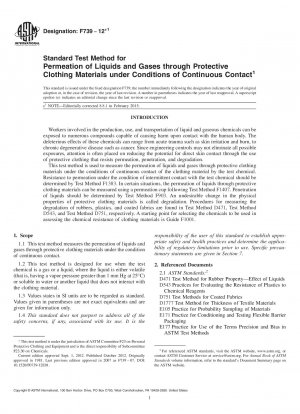ASTM F739-12e1
Standard Test Method for Permeation of Liquids and Gases through Protective Clothing Materials under Conditions of Continuous Contact
- Standard No.
- ASTM F739-12e1
- Release Date
- 2012
- Published By
- American Society for Testing and Materials (ASTM)
- Status
- Replace By
- ASTM F739-20
- Latest
- ASTM F739-20
- Scope
5.1 This test method is normally used to evaluate flat specimens from finished items of protective clothing and from materials that are candidates for items of protective clothing.
5.1.1 Finished items of protective clothing include gloves, arm shields, aprons, suits, hats, boots, respirators, and the like.
5.1.2 The phrase “specimens from finished items” encompasses seamed or other discontinuous regions as well as the usual continuous regions of protective clothing items.
5.2 The breakthrough detection time, standardized breakthrough time, permeation rate, and cumulative permeation are key measures of the effectiveness of a clothing material as a barrier to the test chemical. Such information is used in the comparison of clothing materials during the process of selecting clothing for protection from hazardous chemicals. Long breakthrough detection times, long standardized breakthrough detection times, low amounts of cumulative permeation, and low permeation rates are characteristics of better barriers.
Note 1: At present, only limited quantitative information exists about acceptable levels of dermal contact with most chemicals. Therefore, the data obtained using this test method cannot be used to infer safe exposure levels.
5.2.1 The reporting of a standardized breakthrough time greater than a specific time period means that the test chemical has not permeated the specimen at a rate exceeding 0.1 μg/cm2/min in the designated time. Permeation may or may not have occurred at a lower rate during this time interval.
5.3 The sensitivity of the test method in detecting low permeation rates or amounts of the test chemical that permeate is determined by the combination of the analytical technique and collection system selected, and the ratio of material specimen area to collection medium volume or flow rate.
5.3.1 The analytical technique employed should be capable of measuring the concentration of the test chemical in the collection medium at, or below, levels consistent with the standardized breakthrough time value specified in 3.1.13 and at, or above, the steady-state permeation rate.
5.3.2 Often permeation tests will require measurement of the test chemical over several orders of magnitude in concentration, requiring adjustments in either the sample collection volume or concentration/dilution, or the analytical instrument settings over the course of the test.
5.3.3 Higher ratios of material specimen area to collection medium volume or flow rate permit earlier detection of breakthrough and detection of lower permeation rates and levels of cumulative permeation because higher concentrations of the test chemical in the collection medium will develop in a given time period, relative to those that would occur at lower ratios.
ASTM F739-12e1 Referenced Document
- ASTM D1777 Standard Test Method for Thickness of Textile Materials
- ASTM D471 Standard Test Method for Rubber Property-Effect of Liquids
- ASTM D543 Standard Practices for Evaluating the Resistance of Plastics to Chemical Reagents
- ASTM D751 Standard Test Methods for Coated Fabrics
- ASTM E105 Standard Practice for Probability Sampling Of Materials
- ASTM E171 Standard Specification for Standard Atmospheres for Conditioning and Testing Flexible Barrier Materials
- ASTM E177 Standard Practice for Use of the Terms Precision and Bias in ASTM Test Methods
- ASTM E691 Standard Practice for Conducting an Interlaboratory Study to Determine the Precision of a Test Method
- ASTM F1001 Standard Guide for Selection of Chemicals to Evaluate Protective Clothing Materials
- ASTM F1194 Standard Guide for Documenting the Results of Chemical Permeation Testing of Materials Used in Protective Clothing
- ASTM F1383 Standard Test Method for Resistance of Protective Clothing Materials to Permeation by Liquids or Gases Under Conditions of Intermittent Contact
- ASTM F1407 Standard Test Method for Resistance of Chemical Protective Clothing Materials to Liquid Permeation-Permeation Cup Method
- ASTM F1494 Standard Terminology Relating to Protective Clothing
- ASTM F2815 Standard Practice for Chemical Permeation through Protective Clothing Materials: Testing Data Analysis by Use of a Computer Program
- ASTM F903 Standard Test Method for Resistance of Materials Used in Protective Clothing to Penetration by Liquids
- ISO 6529 Protective clothing - Protection against chemicals - Determination of resistance of protective clothing materials to permeation by liquids and gases
ASTM F739-12e1 history
- 2020 ASTM F739-20 Standard Test Method for Permeation of Liquids and Gases Through Protective Clothing Materials Under Conditions of Continuous Contact
- 2012 ASTM F739-12e1 Standard Test Method for Permeation of Liquids and Gases through Protective Clothing Materials under Conditions of Continuous Contact
- 2012 ASTM F739-12 Standard Test Method for Permeation of Liquids and Gases through Protective Clothing Materials under Conditions of Continuous Contact
- 2007 ASTM F739-07 Standard Test Method for Permeation of Liquids and Gases through Protective Clothing Materials under Conditions of Continuous Contact
- 1999 ASTM F739-99a Standard Test Method for Resistance of Protective Clothing Materials to Permeation by Liquids or Gases Under Conditions of Continuous Contact

Copyright ©2024 All Rights Reserved